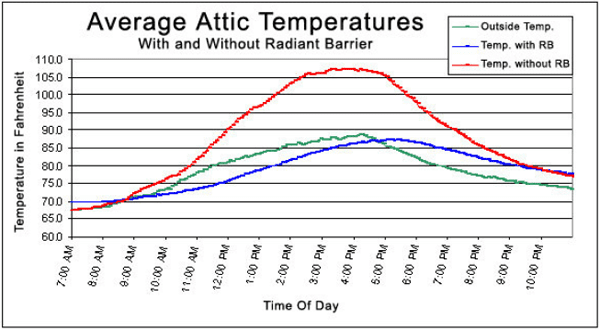In our continued effort to help educate our customers on how radiant barrier works, the science behind it and the different types of radiant barrier, we are now going to focus on the savings radiant barrier provides.
Many Dallas individuals want a hard number or percentage of estimated savings from a radiant barrier, it really is impossible to predict, because there are so many different factors which contribute to its effectiveness or ineffectiveness. However, according to studies done by the U.S. Department Of Energy, it is generally accepted that installing radiant barrier in the attic will reduce heat gain through the ceiling by 40% typically leading up to a 17% reduction on heating and cooling utility bills.
While this 17% figure may hold true for many climates and a typical installation, it will vary from place to place. Many independent studies and radiant barrier users have tested their results and reported energy savings varying from as low as 12% up to as high as 39%.
The graph below shows the attic temperature difference between two similar attics spaces, one with a radiant barrier installed and the other without. As you can see, the attic with the radiant barrier(blue) stayed much cooler throughout the day.
This report is not meant to give hard figures, rather it is meant to give the potential radiant barrier user/installer the proper information to make the most informed decision possible. With that being said, the section below will list and describe some of the main factors which will affect the performance of a radiant barrier installation.
Main Factors Determining Radiant Barrier Effectiveness:
- Attic Ductwork – If ductwork or air handlers are located in the attic, the temperature of the attic area will affect the efficiency of the HVAC system. Using a Radiant Barrier to control attic temperatures will increase HVAC system efficiency, thus reducing energy costs.
- Existing Insulation – If existing attic insulation is less than a R39, a Radiant Barrier installation will help to stop excess radiant heat. Homes with a R39 or higher ceiling-insulation, and have no ductwork in the attic will not achieve much energy savings from a Radiant Barrier installation.
- Cold Climates – In climates where the majority of annual energy usage goes towards heating the structure, a radiant barrier on the floor of the attic, above the insulation and ductwork will provide substantial energy savings.
- Hot Climates – In climates where the majority of annual energy usage goes towards cooling the structure, a radiant barrier stapled to the bottom of the roof rafters will provide maximum energy savings.
- Mild Climates – In more mild climates where neither heating nor cooling is used much, a radiant barrier installation will not create massive energy savings. However, the Radiant Barrier can increase the overall comfort of the structure while providing small to moderate energy savings.

